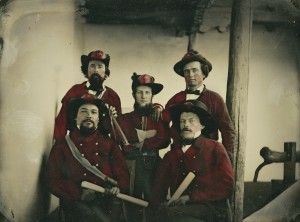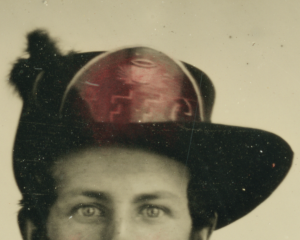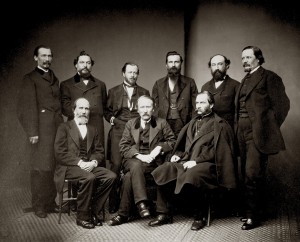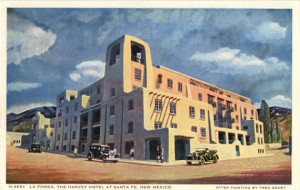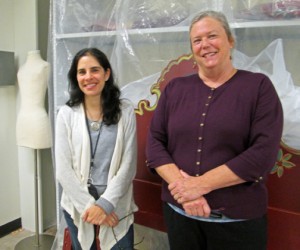 The New Mexico History Museum recently welcomed two new staffers to the collections vault, left virtually empty when Collections Technician Patrick Cruz left us for graduate school at the University of Colorado, Boulder. Deborah King takes over as registrar, and Yasmin Hilloowala as assistant collections manager. (Deborah, at right in the photo at left, isn’t precisely a newcomer. She worked at the museum prior to its opening and most recently worked in collections at the Museum of International Folk Art.)
The New Mexico History Museum recently welcomed two new staffers to the collections vault, left virtually empty when Collections Technician Patrick Cruz left us for graduate school at the University of Colorado, Boulder. Deborah King takes over as registrar, and Yasmin Hilloowala as assistant collections manager. (Deborah, at right in the photo at left, isn’t precisely a newcomer. She worked at the museum prior to its opening and most recently worked in collections at the Museum of International Folk Art.)
Tell us a bit about where you’re from and how you ended up in museum work.
Deborah King: San Antonio, Texas, is my hometown. I studied anthropology at the University of Texas at San Antonio, and enjoyed the field work and archaeological collections process. I moved to New Mexico in 1985 and continued my work with the National Park Service, helping with collections for 37 different parks and monuments in the Southwest.
Yasmin Hilloowala: I ended up in museum work because I got a part-time job in the collections department at the Arizona Historical Society while I was in graduate school at the University of Arizona. One of the first tasks I did was to catalog a set of Christmas ornaments. I knew from then on that I wanted to work in museums.
What made a job at the History Museum enticing?
Deborah: I have always been passionate about historic structures, so the opportunity to work at the Palace of the Governors is very attractive. Having worked with the collections before, I am aware of the great significance and historic relevance these objects hold.
Yasmin: Most of my career has been spent in history museums. They are the most interesting because they have such a variety of collections.
What are some of the challenges of our collections?
Deborah: The biggest challenge is preserving the Palace of the Governors. The building is subjected to the very things we protect against in the climate-controlled environment of collection storage—temperature, humidity, light levels, bugs, rodents and handling. It takes a dedicated team working together to maintain its integrity.
Yasmin: The variety of artifacts makes housing and caring for the collections challenging.
What’s your favorite artifact so far?
Deborah: The Palace of the Governors.
Yasmin: A lusterware charger on display in the Palace because it is related to my academic field, which is Middle Eastern art and history.
What do you collect for your own home?
Deborah: I create and collect memories. The repository of these intangible memoirs will be with my children with no space requirements.
Yasmin: I don’t collect anything. Managing a collection cures you of wanting your own collection.

